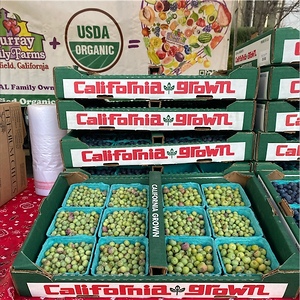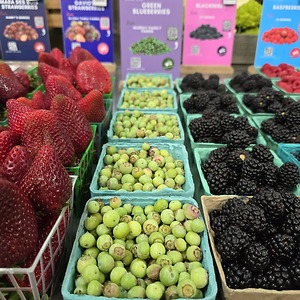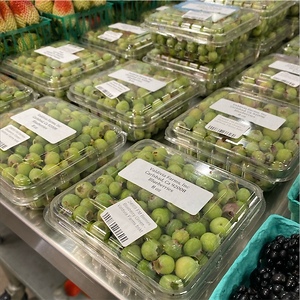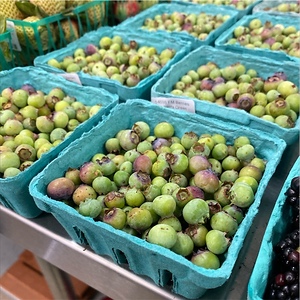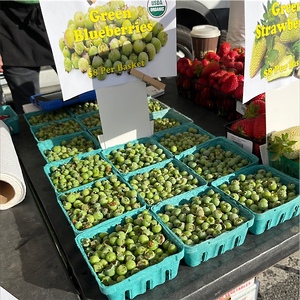


Green Blueberries
Estimated Inventory, bskt : 0
This item was last sold on : 06/16/25
Description/Taste
Green blueberries are small in size, averaging 0.5 to 1.5 centimeters in diameter, and have a round to oblate shape with a blunt, curved nature. The fruits characteristically feature a star-shaped crown at the base or stem end, which is also known as the calyx, and the skin is thin, firm, smooth, and taut. Green blueberries showcase variegated hues of green to light green with purple, pink, and red accents. The fruit’s age determines the degree of coloring, as each blueberry ripens at its own pace and is picked at different times. Underneath the surface, the pale green flesh is aqueous, crisp, crunchy, and succulent, containing tiny seeds in the center of the fruit. Green blueberries have a refreshing, bright quality to their overall flavor. The fruits are edible raw, pickled, or cooked, and bear tart, acidic, sour, and tangy green, fruity nuances. Some consumers consider Green blueberries too overpowering when eaten raw, while others enjoy their mouth-puckering sourness. Raw Green blueberries should only be eaten fresh in small quantities. When pickled or cooked, their tanginess is combined with other flavors to create a balanced and complex flavor profile.
Seasons/Availability
Green blueberries are available in the spring through summer.
Current Facts
Green blueberries are botanically part of the Vaccinium genus and are unripe fruits belonging to the Ericaceae family. Three main species of blueberries are sourced for edible fruits, including Vaccinium Corymbosum, the Highbush blueberry, Vaccinium angustifolium, the Wild or Lowbush blueberry, and Vaccinium virgatum, the Rabbiteye blueberry. Green blueberries are picked while still immature, semi-firm, and have an acidic, tart, and sour flavor. The fruits are a specialty culinary item not commonly found in commercial markets but are increasing in popularity as a creative seasonal ingredient. It is important to note that blueberries do not ripen after they are picked. Their coloring and texture may soften and change, but their flavor remains the same at their maturity stage at harvest. Green blueberries add tangy nuances and enhance and accent the overall taste of culinary dishes. Chefs and home cooks typically pickle or cook the fruits with sweet, savory, salty, and spice-filled flavors to elevate complex dishes.
Nutritional Value
Green blueberries have not been studied for their nutritional properties. It is important to note that eating raw, unripe berries may cause gastrointestinal discomfort if consumed in large quantities. It is recommended to cook or pickle Green blueberries and to eat the fruits in small amounts. In North America, the Wabanaki tribe has historically used portions of wild blueberry plants for medicinal purposes. The tribe believed that blueberries provided stamina as they were the favorite fruit of bears, and the fruits could be dried and stored for extended use. Blueberries were also used in teas and syrups for throat irritations.
Applications
Green blueberries have a sour, tart, and acidic flavor suited for pickled and cooked preparations. The unripe fruits are eaten raw by some chefs as a sour accent in dishes, but they should only be added in small quantities. Green blueberries can be tossed into green salads with rich cheeses, nuts, and vinaigrettes, or they can be halved and added to salsa and slaws. The fruits are also sometimes used in variations of Cambodian salads instead of green mango or added to smokey, spicy, and seafood-rich condiments. In the United States, Green blueberries are famously fermented and pickled. The pickled fruits develop herbal notes and are served on cheese boards, used as a topping over grilled vegetables, or chopped into relishes. They can also be mixed into potato salads, folded into rice dishes, or added as a pop of flavor. Green blueberries can be used as a caper substitute in beef tartar or fish dishes with halibut, hamachi, and tuna. They also complement dishes with pork belly, duck, and lamb. Beyond adding whole fruits, pickled Green blueberries can be roughly chopped into chutneys or achar, a traditional Indian condiment served with rice or stews. They can also be mixed with ripe blueberries in sauces, syrups, and cocktails. Green blueberries pair well with spring vegetables like asparagus, artichokes, peas, green strawberries, green almonds, leeks, and fiddleheads, ginger, garlic, honey, shiso, and nasturtiums. Whole, unwashed Green blueberries can be stored for several days to a few weeks in the refrigerator. They can also be frozen for several months.
Ethnic/Cultural Info
Green blueberries are used for depth in culinary dishes by adding refreshing, pleasantly sour, and fruity nuances. In the United States and Europe, the unripe fruits are occasionally sourced to make a variation of verjus, an ancient souring agent. Verjus can be traced under other names to the Middle East and was once used as a flavoring in dishes throughout ancient Persia. It also quickly spread throughout the Mediterranean and was notably used in recipes of the ancient Romans. By the Middle Ages, verjus was a common culinary and medicinal ingredient throughout Europe, especially in France, where the name verjus was taken from the words “vert jus,” meaning “green juice.” Traditionally, verjus is made from the juice of pressed unripe grapes. In the modern day, Green blueberries are being substituted for grapes and are used as an innovative alternative in culinary dishes. Green blueberry verjus can be used almost interchangeably with regular verjus and is favored for its less overpowering flavor. Verjus is incorporated in marinades, salad dressings, vinaigrettes, and cocktails. It can also be added to various desserts and sauces, adding acidity to dishes without destroying the palate.
Geography/History
Green blueberries are native to North America, and wild species have been naturally growing since ancient times. There are several species of blueberries found throughout the United States and Canada, and Native Americans were the first people group to utilize various parts of the plant for culinary and medicinal purposes. It wasn’t until the early 20th century that wild blueberry species were domesticated and cultivated commercially. In 1893, Elizabeth White saw the potential in wild blueberries and began investigating the possibility of cultivation. During this time, Ms. White’s family owned one of the largest cranberry farms in New Jersey, and wild blueberry bushes often appeared on their property. In 1908, USDA botanist Frederick Coville also studied the blueberry’s potential as a commercial plant. Mr. Coville wrote a book called “Experiments in Blueberry Culture,” which covered his early research on the species. Ms. White read Mr. Coville’s book, and the two blueberry enthusiasts joined forces to release the first commercial blueberries in 1916. Since their commercial debut, new varieties of blueberries have been developed and planted worldwide as a fresh fruit. Green blueberries are the unripe versions of the berries harvested before they change color and develop a sweeter flavor. The sour fruits are foraged from wild and cultivated plants and sold through select markets and distributors as a specialty product. Today, Green blueberries are seasonally available in small quantities, and various species are utilized worldwide to harvest the young fruits.
Recipe Ideas
Recipes that include Green Blueberries. One



